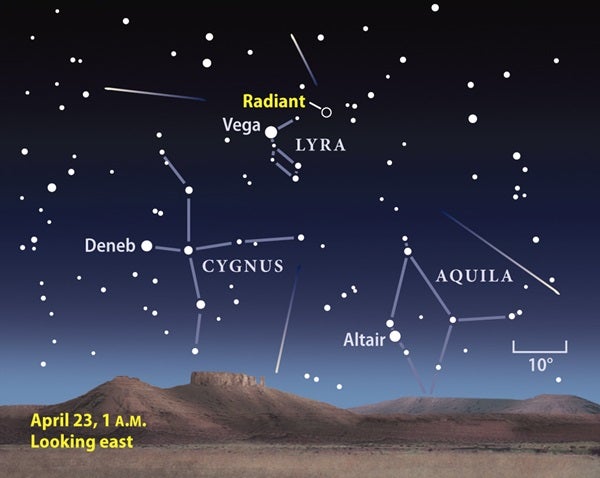Streaking swiftly across the sky, motes of dust burn up as meteors. Although Earth constantly sweeps up interplanetary debris, our planet runs through a slightly denser cometary trail this month. Named after the constellation from which the meteors appear to radiate, the annual Lyrid meteor shower peaks on the evening of April 22 and the morning of the 23rd.
The constellation Lyra the Harp is easy to find because its luminary is the brilliant blue-white star Vega. It ranks fifth-brightest of all nighttime stars.
The Lyrid shower produces meteors from April 16 to 25 and peaks with about 20 meteors per hour after midnight April 23. Unfortunately, the Moon attains its full phase April 17. On the night the Lyrids peak, 69 percent of our satellite’s surface will appear illuminated. Even so, observers located away from city lights should easily spot the brightest shower members.
The Lyrid’s radiant is high in the sky by midnight local daylight time, about an hour after the Moon appears above the eastern horizon. The highest hourly rates occur a few hours before dawn on April 23, when Lyra rides nearly overhead.
Rates can reach 20 meteors per hour, and occasionally more. During the past several decades, observers have reported sporadic outbursts that pushed hourly rates past 60 meteors. The predawn hours offer the best viewing because that’s when your location will be facing Earth’s direction of travel in its orbit. In essence, Earth will be running into the meteors.
Lyrid meteors are fast and generally as bright as the Big Dipper’s stars. The particles we see as meteors originated from Comet Thatcher (C/1861 G1).
It’s best to view meteor showers without optical aid. Viewers should use just their eyes so as not to restrict the field of view. Before moonrise, face eastward and look about halfway up. After the Moon appears, looking overhead or even toward the west (away from the Moon’s direction) will probably net you the most meteors.
Astronomy magazine Associate Editor Bill Andrews summed up the lure of the Lyrids and other showers: “Meteor showers are nothing but fun,” he said. “Grab your family and friends and head to a dark location. You don’t need much — a lawn chair, blanket, and a hot drink. You won’t even need a telescope because it will restrict your field of view too much.”
Interesting facts about meteors
- Most visible meteors lie within 120 miles (200 kilometers) of an observer.
- Meteors become visible at an average height of 55 miles (90 km). Nearly all burn up before they reach an altitude of 50 miles (80 km).
- No known meteorite has been associated with a meteor shower. (That is, no shower meteor has ever survived its flight through the atmosphere and been recovered.)
- The typical bright meteor is produced by a particle with a mass less than 1 gram with a size no larger than a pea.
- The average total mass of meteoritic material entering Earth’s atmosphere is estimated to be between 100 and 1,000 tons (91,000–910,000 kilograms) per day.
- The hourly rate on a “non-shower” night is approximately 6 meteors per hour.
- A meteoroid enters the atmosphere at velocities between 25,000 and 165,000 mph (40,300–265,000 km/h).
- Video: How to observe meteor showers, with Michael E. Bakich, senior editor
- Video: Easy-to-find objects in the 2011 spring sky, with Michael E. Bakich, senior editor
- StarDome: Locate constellation Lyra the Harp in your night sky before this meteor shower with our interactive star chart.
- Sign up for our free weekly e-mail newsletter.











